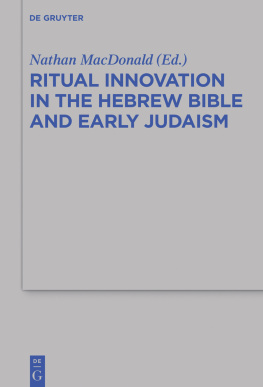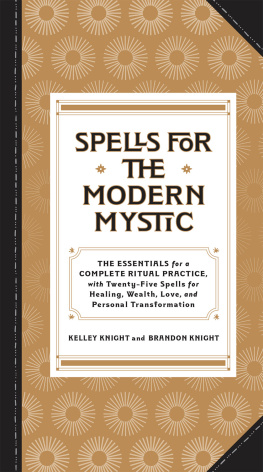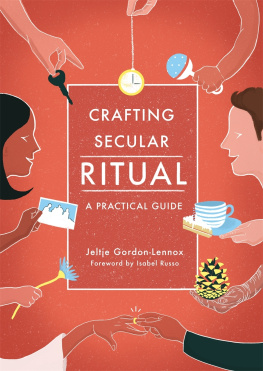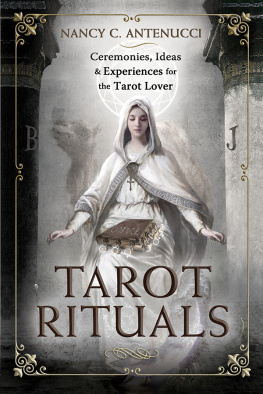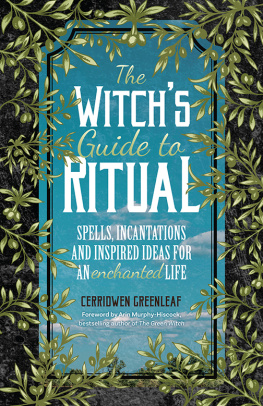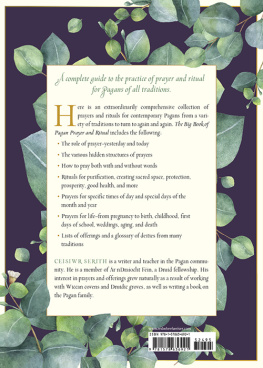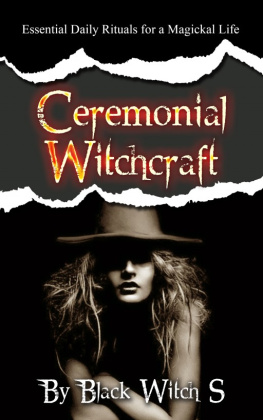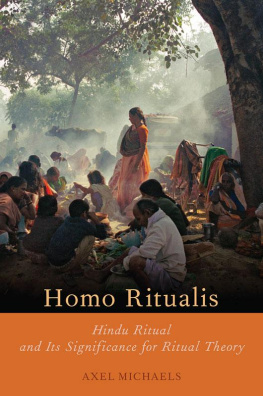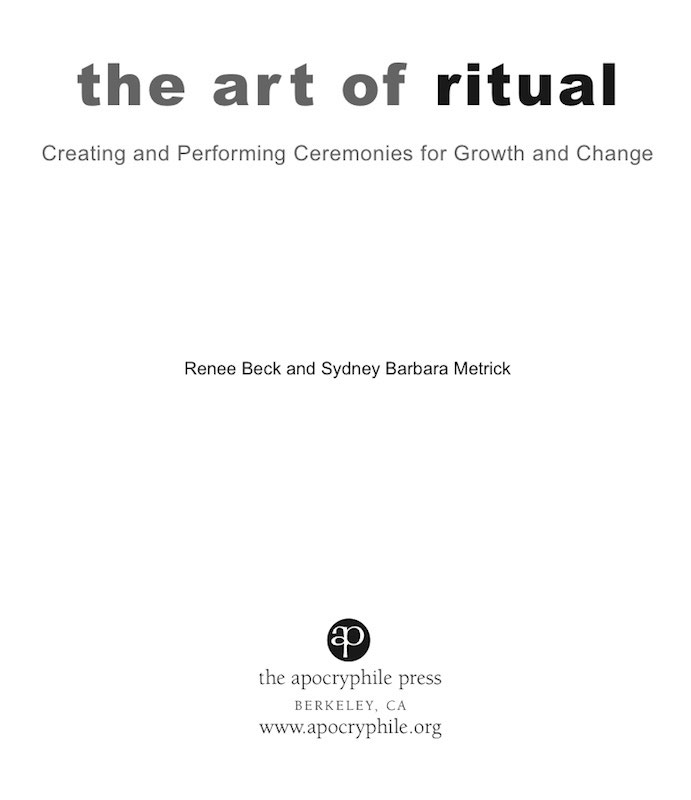the art of ritual
dedication
To Roie Beck, who instilled in me a great wonderment for ritual, God, and mystery.
Renee Beck
To my oldest and dearest friend, Hank Matthews, who always has me focus on the bright side of life.
Sydney Barbara Metrick
acknowledgments
We wish to thank Celestial Arts for recognizing the need for ritual in our culture. We extend our deepest appreciation to Julie Bennett, our editor, for her time, energy, and positive suggestions in improving the second edition of The Art of Ritual. Special thanks to Terry Hatcher, whose delightful artwork brings beauty to the pages of this book. And thanks to Angeles Arrien for her work with ritual, and for contributing the foreword.
Renee extends great appreciation to the Holy One for making the process go so smoothly all down the line.
contents
Appendixes
foreword
All cultures recognize the need to ritualize major life transitions. In 1929 anthropologist Arnold van Gennep coined the term rite of passage to describe the universal practice of ceremonializing lifes major events, including (1) birthnewness; (2) entrymaking contact with others; (3) initiationwillingness to learn something new and be tested on it; (4) marriage/mergencecapacity for commitment, integration, and unifying opposites; (5) demonstrationability to facilitate, heal, teach, guide; (6) attainmentinner contentment, modeling a skill or talent; and (7) deathletting go, moving out from the old into the new.
In his introduction to van Genneps The Rites of Passage (University of Chicago Press, 1960), Solon Kimbala said that it is likely that one dimension of mental illness may arise because an increasing number of individuals are forced to accomplish their transitions alone and with private symbols. In The Art of Ritual, authors Beck and Metrick have created a practical healing manual that provides specific steps and guidelines for rituals. Their book will help individuals and groups learn the art of supporting life changes as well as how to honor the space and time between transitions, an equally important subject largely ignored by this culture. Bill Bridges, in his book Transitions: Making Sense of Lifes Changes (Perseus Publishing, 1980), calls the area between changes the neutral zone. The Africans refer to this as walking the land of gray clouds. We might call this time the land of I-dont-know.
Our culture has not learned how to support the time between rites of passage or how to honor the need to take the time to incorporate life experiences. During most major life events, for example, a person in this culture is supported strongly for a few weeks or a month, but after that, support problems surface. A person between jobs might be asked, Well, when are you going to get your next job? A recently married couple might be asked, When are you going to have a baby? Someone experiencing the death of a loved one might be asked, When are you going to get going again? The minimum time required by an individual to integrate a consequential life experience is one year, and some people require two years. If one doesnt take time to absorb these experiences when they occur, they can emerge years later and cause other problems, such as untimely depression or unresolved grief. Our lives may be running smoothly, yet a sense of meaninglessness may be present. Such unhappy states indicate the surfacing of unresolved transitions.
One way this culture recognizes the need to ritualize and support change in others is by sending greeting cards. Our society, as it accelerates at a faster rhythm, experiences change at a swifter pace. Greeting cards are quick, efficient messages of support in our rapidly changing world. However, in a slower-moving society in which spending time with an individual or family is a major way of extending support, greeting cards would not be appropriate.
To survive in the twenty-first century, people must become more capable of handling change than ever before. Alvin Toffler elaborates on this idea in his visionary book Future Shock (Bantam Books, 1970) when he states, We have the opportunity to introduce additional stability points and rituals into our society, such as new holidays, pageants, ceremonies, and games. Such mechanisms could not only provide a backdrop of continuity in everyday life but serve to integrate societies, and cushion them somewhat against the fragmenting impact of super-industrialism. Essentially, the challenge in the next century will be to become the change master, a term Rosabeth Moss Kanter introduced in the 1980s. Kanter identifies ways we cope, manage, resist, or creatively approach change.
The Art of Ritual gives Ten Guidelines for Creating Your Own Rituals in Chapter 8: Ritual Guidelines and Worksheet to assist you during times of change. Beck and Metrick also give examples of ways to integrate your experience. They remind us that human beings have used ritual for centuries as an important buffer to change and as a way of consciously recognizing and supporting a life event rather than denying or indulging in it. The Art of Ritual provides a structure to recall the truth of Novaliss statement that the seat of the soul is where the outer and inner worlds meet. Ritual provides the bridge between inner and outer worlds and creates a context for reconnecting to the seat of our souls. The end results of all ritual are increased balance, strength, energy, and comfort. This is an important book whose time has come.
Angeles Arrien
Cultural Anthropologist
introduction
It is the nature of human beings to grow, to evolve, to increase relationships with ourselves, each other, our world, and with our sense of Spirit. The substance of our lives is based in this process. Connecting with our creative resources, our recognition of wholeness, and more important, with the knowledge that we are part of something much larger that is eternal and omnipresent makes the difference between merely existing and living fully.
Ritual has been a viable access to such a connection throughout human history. The rituals our ancestors used thousands of years ago focused our relationships with the land, the seasons, the hunt, with others in the tribe, and relationships between tribes. Human needs have remained the same, but survival has become more complex. The rituals handed down to us are frequently insufficient to address and satisfy our personal and spiritual needs and often cannot heal us from the separation and alienation so too often experienced in todays world. It is more than apparent that our society and our world are in a frightening and dangerous condition.
The authors have practiced the symbolic and ritual arts for over thirty years and worked as counselors and teachers for over twenty. Through our own inner quests and our intimate work with people dealing with lifes challenges, we have come to recognize the need for personalized and meaningful rituals in peoples lives. We have created and performed rituals for ourselves, our friends and families, our clients and students. We have learned that creating rituals is not a one size fits all process. By being open to differences and possibilities, we have developed and refined the ritual process presented here. We designed this book of ritual guidelines to offer you the means to help yourself, and others, through lifes transitions. When you turn to this book to help you create a ritual to dramatize, comment on, and shape an event, you give yourself the opportunity to be at cause: to be connected with your center, your purpose, your relatedness to other people, our universe, and Spirit. You empower yourself.



